The Canned Fruits Market is estimated to be valued at USD 10.3 billion in 2025 and is projected to reach USD 12.5 billion by 2035, registering a compound annual growth rate (CAGR) of 1.9% over the forecast period.
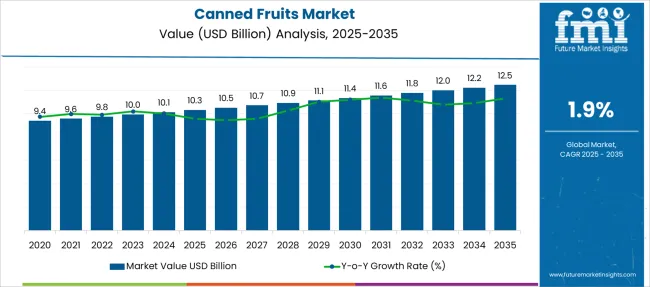
| Metric | Value |
|---|---|
| Canned Fruits Market Estimated Value in (2025 E) | USD 10.3 billion |
| Canned Fruits Market Forecast Value in (2035 F) | USD 12.5 billion |
| Forecast CAGR (2025 to 2035) | 1.9% |
The canned fruits market is experiencing robust growth driven by rising demand for shelf stable nutritious food products and the growing need for convenient meal solutions. As urban lifestyles continue to accelerate, consumers are turning to canned fruits for their long shelf life, minimal preparation requirements, and year round availability.
Advances in canning technologies have enhanced nutritional retention and flavor profiles, addressing earlier consumer concerns about quality. The rising influence of clean label trends and the shift toward preservative free options are also contributing to market expansion.
Additionally, the ability of canned fruits to support food security goals and reduce post harvest waste has increased their importance in global food supply chains. Looking ahead, the market is expected to maintain positive momentum as both retailers and consumers prioritize convenience, safety, and sustainability in their purchasing decisions.
The market is segmented by Nature, Form, and Distribution Channel and region. By Nature, the market is divided into Organic and Conventional. In terms of Form, the market is classified into Whole Fruit and Cut Fruit. Based on Distribution Channel, the market is segmented into Supermarkets/Hypermarkets, Online Retail Stores, Specialty Stores, and Others. Regionally, the market is classified into North America, Latin America, Western Europe, Eastern Europe, Balkan & Baltic Countries, Russia & Belarus, Central Asia, East Asia, South Asia & Pacific, and the Middle East & Africa.
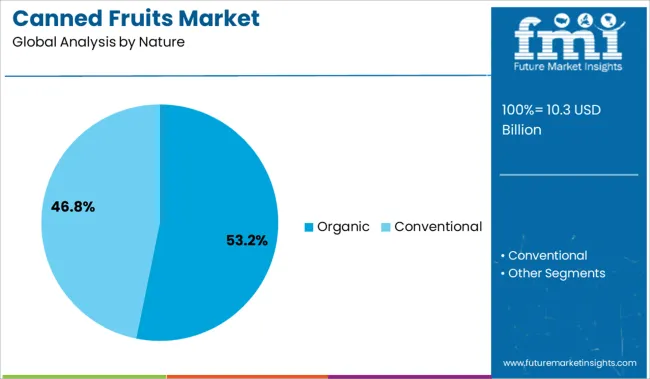
The organic segment is anticipated to account for 53.20% of total market revenue by 2025 within the nature category, making it the dominant segment. This growth is being driven by increasing consumer preference for clean label, pesticide free, and non genetically modified food products.
Organic canned fruits are viewed as healthier and more environmentally responsible choices, aligning with broader wellness and sustainability trends. Producers have responded to this demand by expanding certified organic product lines and ensuring transparent sourcing practices.
The rise of ethical consumerism and willingness to pay a premium for organic labels has further reinforced the segment's leadership in the canned fruits market.
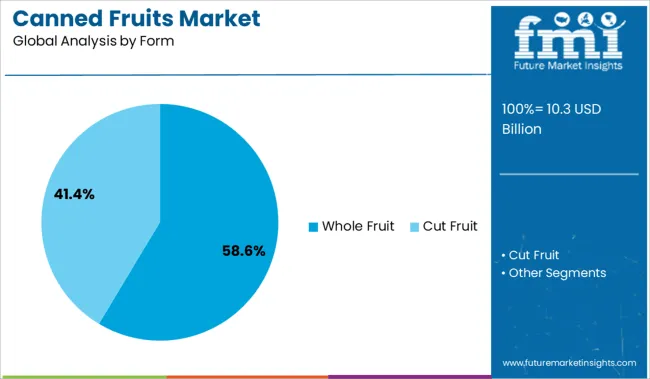
The whole fruit segment is projected to hold 58.60% of total revenue by 2025 within the form category, establishing it as the leading segment. Consumers are favoring whole fruit formats for their visual appeal, texture retention, and perception of freshness.
Whole fruits offer versatility in culinary use, including direct consumption, baking, and meal preparation, contributing to their popularity in both household and food service channels. The convenience of pre cut and preserved whole fruits also aligns with the fast paced lifestyles of urban consumers.
As brands focus on maintaining product integrity through improved canning processes, the whole fruit format continues to outperform other forms in the market.
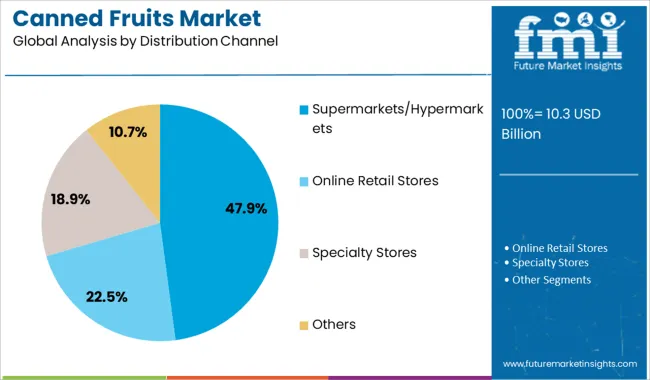
The supermarkets and hypermarkets segment is expected to contribute 47.90% of total market revenue by 2025 under the distribution channel category, making it the leading sales channel. This is due to the widespread availability, bulk purchasing options, and promotional strategies employed by large retail chains.
Consumers prefer these outlets for the ability to compare brands, access discounts, and find a broad range of canned fruit varieties. Additionally, improvements in in store merchandising, private label penetration, and product placement have enhanced consumer engagement.
With increasing foot traffic and trust in organized retail formats, supermarkets and hypermarkets remain the primary choice for purchasing canned fruits globally.
Demand for canned fruit is expected to rise as the global urban population rises.
The rate of urbanization has increased dramatically in recent decades. The result is a dramatic increase in the number of people living in metropolitan areas, which has consequential effects on people's ways of life and raises the prevalence of multi-member households. As a result, there is a need for ready-to-eat food items because of people's hectic schedules.
Sales of canned fruits are projected to benefit from the growing desire for convenient and easily transportable food storage options, as well as the expanding popularity of convenience foods. Customers are likely to favor canned food goods because of their ability to preserve an elevated level of nutrients and flavor.
The current reliance of consumers on packaged fruits is projected to fuel the need for food goods with a longer shelf life due to the increasing number of working women around the world. As a result of these variables, the canned fruit industry is expected to grow at a rapid clip in the future.
A major barrier to canned fruit's widespread use is the high price of production.
Prices for canned fruits fluctuate frequently and are not stable. The cost of canning also rises or falls depending on the availability of the fruit being canned, therefore price changes are to be expected. As a result, the final cost of various canned fruits may fluctuate, which is expected to reduce growth prospects in the global market.
Need for Naturally Preserved and Fresh Food Is Growing
There has been a significant shift in consumer preferences toward fresh, minimally processed foods in recent years, which is predicted to have a detrimental effect on the uptake of these fruits.
However, in recent years, there has been a rise in the urban population's preference for ready-made foods and drinks, such as canned cocktails. There is also speculation that declining interest in cooking at home may eventually destroy the market.
Consistently shifting eating patterns toward a greater intake of canned fruit
Changes in people's eating patterns are a major factor in the boom in canned fruit sales. Growth in the industry is being fueled in no small part by people's hectic schedules, their increasing ability to spend money, and the rising pace of urbanization. These market shifts have ensured that canned fruits are expected to always have a place in people's kitchens and pantries.
Additionally, canned fruits are widely accessible, and consumers around the world are becoming more aware of the nutritional benefits of these products. In addition, the global market is opening due to their low prices compared to fresh fruits.
Economic regions that do not have the right climate for growing certain fruits receive cans of those fruits from other places. Because of this, people in these locations have access to a wider variety of fruits than they would otherwise have if canned fruits were not readily available.
Canned peaches, canned pineapples, canned mixed fruits, canned citrus fruits, canned pears, and other products all makeup subsets of the overall canned fruits market. Canned peaches, for example, are projected to be worth about USD 12.5 Billion by 2035's conclusion. Sales of these items are expected to grow at a CAGR of 3.5% between now and 2035.
The canned fruit industry can be segmented into supermarkets and hypermarkets, specialty stores, and grocery stores. Supermarkets and hypermarkets are where consumers choose to buy canned fruits. Thus, they are anticipated to maintain a dominant position in the global market.
This market sector has become dominant due to the proliferation of chain hypermarkets in rich countries and their growing popularity in emerging economies. Customers' hectic schedules, combined with the growing number of people used to the convenience lifestyle, are expected to fuel expansion prospects in this market.
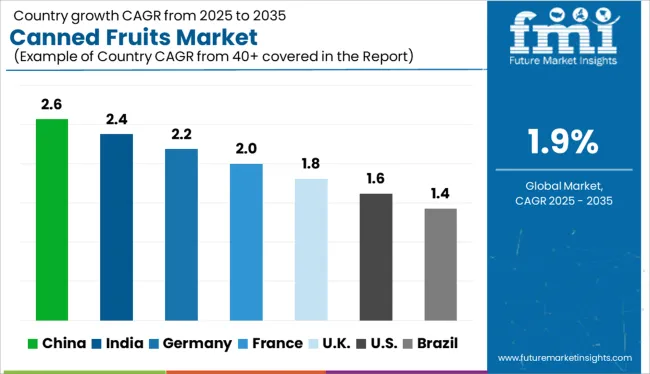
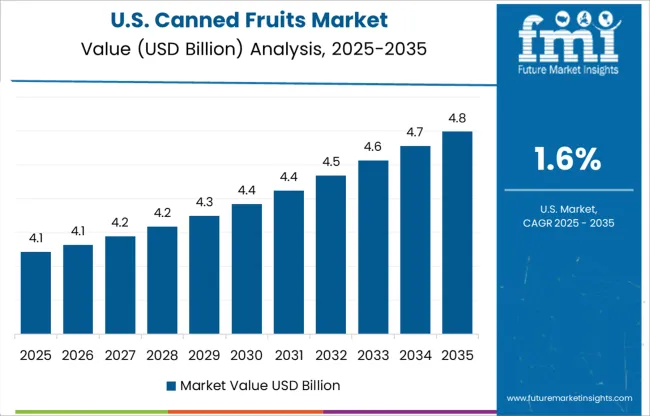
Advances in transportation and refrigeration methods have facilitated the transcontinental transfer of perishable and low-storage-capacity goods. Increased demand and reported growth in the North American canned fruits industry can be attributed to the rapidly urbanizing population, rising per capita income, and hectic lifestyles.
Furthermore, the safety of the food we eat has been and is likely to continue to be of paramount importance to all shoppers. It is now possible to process fruits in a more efficient manner thanks to the introduction of high-tech devices, including new optical color and laser sorters, custom-designed pitting and processing lines, high-speed packing lines, and on-site freezing and frozen storage.
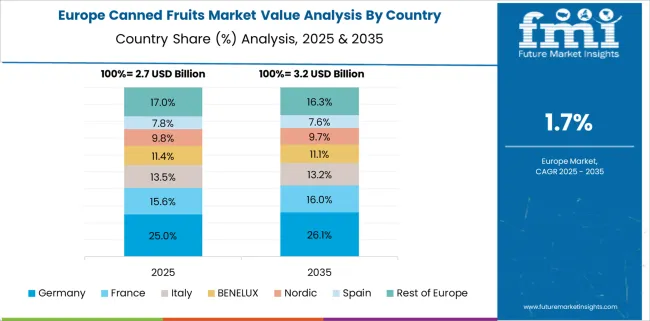
Europe has almost a 70% share of the world's total imports of canned fruits and vegetables, making it the largest importing region by far.
It is expected that the European demand for canned fruits could expand by 1-2% per year over the next five years. Innovations that enhance canning technology are crucial to the expansion of the market.
Spending more on Research and Development means more healthy options, more accurate nutrition labels, and more convenient packaging (ready-to-eat foods). The developing infrastructure for transporting canned foods across Europe is also expected to boost demand.
Germany, as the largest food market in Europe, makes for an intriguing target market. As Europe's largest organic canned fruits market, Germany also presents unique potential for organically certified canned fruits and vegetables.
Since the United Kingdom and France have lesser production output than Spain and Italy, they come in second and third, respectively. Smaller markets for canned fruits and vegetables, the Netherlands and Belgium nonetheless make the top six since they serve as re-exporters.
The South Korean canned fruits market is expected to grow at a CAGR of 5.5%. The market is valued at USD 10.3 Million in 2025 and is anticipated to reach USD 12.5 Million by 2035.
| Market Value (2025) | USD 10.3 Million |
|---|---|
| Market Value (2035) | USD 12.5 Million |
| CAGR | 5.5% |
Rapid urbanization, a rise in the number of nuclear homes, hectic lifestyles, an increase in the demand for portable storage techniques for food goods, and the rising popularity of convenience meals are all contributing to the expansion of the demand for canned fruits. However, the prohibitive cost of canned fruits and the availability of less expensive packaging options are restraining the sales of canned fruits.
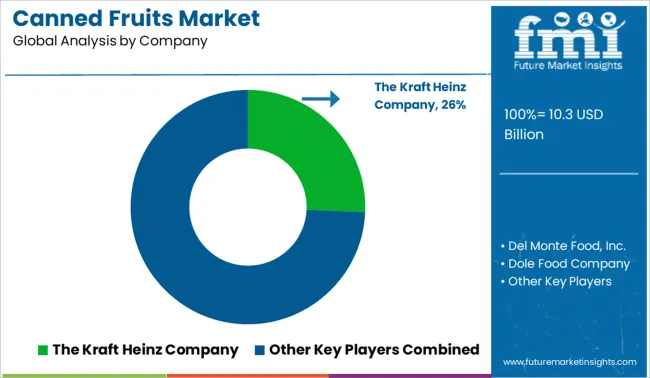
New competitors can find success by taking innovative steps.
Profitable as it may be, the canned fruits industry is frequently disregarded. Since most new businesses are focusing on processed and packaged foods those involved in the sector can guarantee consumers have access to fresh, unaltered fruit, fruit canning might be a lucrative business.
Even though the demand for canned fruits is already saturated, new companies can try breaking in by offering canned fruit in interesting or unusuaflavorsrs. Fruit consumption is on the rise as people become more aware of the positive effects that a healthy diet can have on their bodies. As a result, businesses can put money into various forms of research and development to produce novel products and services for consumers.
EEC Organization has consistently placed a premium on ensuring the security of its food supply. The leaders in the global canned fruit industry understand this and only sell the best, most sanitary products to their customers. Additionally, the advent of several high-tech machines, such as custom-designed pitting & processing lines, modern optical laser and color sorters, on-site freezing & frozen storage, and high-speed packing lines, has simplified and expedited the fruit processing procedure.
Del Monte Foods, The Kraft Heinz Company, Conagra Foods, Rhodes Food Group, Dole Food Company, Kangfa Foods, Seneca Foods, CHB Group, Gulong Food, Tropical Food Industries, and Others are all major competitors in the global canned fruits market.
The global canned fruits market is estimated to be valued at USD 10.3 billion in 2025.
The market size for the canned fruits market is projected to reach USD 12.5 billion by 2035.
The canned fruits market is expected to grow at a 1.9% CAGR between 2025 and 2035.
The key product types in canned fruits market are organic and conventional.
In terms of form, whole fruit segment to command 58.6% share in the canned fruits market in 2025.






Our Research Products

The "Full Research Suite" delivers actionable market intel, deep dives on markets or technologies, so clients act faster, cut risk, and unlock growth.

The Leaderboard benchmarks and ranks top vendors, classifying them as Established Leaders, Leading Challengers, or Disruptors & Challengers.

Locates where complements amplify value and substitutes erode it, forecasting net impact by horizon

We deliver granular, decision-grade intel: market sizing, 5-year forecasts, pricing, adoption, usage, revenue, and operational KPIs—plus competitor tracking, regulation, and value chains—across 60 countries broadly.

Spot the shifts before they hit your P&L. We track inflection points, adoption curves, pricing moves, and ecosystem plays to show where demand is heading, why it is changing, and what to do next across high-growth markets and disruptive tech

Real-time reads of user behavior. We track shifting priorities, perceptions of today’s and next-gen services, and provider experience, then pace how fast tech moves from trial to adoption, blending buyer, consumer, and channel inputs with social signals (#WhySwitch, #UX).

Partner with our analyst team to build a custom report designed around your business priorities. From analysing market trends to assessing competitors or crafting bespoke datasets, we tailor insights to your needs.
Supplier Intelligence
Discovery & Profiling
Capacity & Footprint
Performance & Risk
Compliance & Governance
Commercial Readiness
Who Supplies Whom
Scorecards & Shortlists
Playbooks & Docs
Category Intelligence
Definition & Scope
Demand & Use Cases
Cost Drivers
Market Structure
Supply Chain Map
Trade & Policy
Operating Norms
Deliverables
Buyer Intelligence
Account Basics
Spend & Scope
Procurement Model
Vendor Requirements
Terms & Policies
Entry Strategy
Pain Points & Triggers
Outputs
Pricing Analysis
Benchmarks
Trends
Should-Cost
Indexation
Landed Cost
Commercial Terms
Deliverables
Brand Analysis
Positioning & Value Prop
Share & Presence
Customer Evidence
Go-to-Market
Digital & Reputation
Compliance & Trust
KPIs & Gaps
Outputs
Full Research Suite comprises of:
Market outlook & trends analysis
Interviews & case studies
Strategic recommendations
Vendor profiles & capabilities analysis
5-year forecasts
8 regions and 60+ country-level data splits
Market segment data splits
12 months of continuous data updates
DELIVERED AS:
PDF EXCEL ONLINE
Canned Wet Cat Food Market Size and Share Forecast Outlook 2025 to 2035
Canned Food Packaging Market Size and Share Forecast Outlook 2025 to 2035
Canned Wine Market Size and Share Forecast Outlook 2025 to 2035
Canned Pet Food Market Analysis - Size and Share Forecast Outlook 2025 to 2035
Canned Food Packaging Industry Analysis in the United Kingdom Size and Share Forecast Outlook 2025 to 2035
Overview of Key Trends Shaping Canned Tuna Business Landscape.
Canned Soup Market Size and Share Forecast Outlook 2025 to 2035
Canned Mackerel Market Analysis - Size, Share, and Forecast Outlook 2025 to 2035
Canned Anchovy Market Analysis - Size, Share, and Forecast Outlook 2025 to 2035
Canned Seafood Market Size, Growth, and Forecast for 2025 to 2035
Canned Alcoholic Beverages Market Analysis by Product Type, Distribution Channel, and Region Through 2035
Canned Tuna Ingredients Market Analysis by Ingredients Type and End User Through 2035
Leading Providers & Market Share in Canned Tuna Industry
Canned Meat Market Insights - Industry Growth & Demand 2025 to 2035
Canned Pasta Market Trends - Convenience & Consumer Preferences 2025 to 2035
Canned Legumes Market Insights – Protein-Packed Convenience Foods 2025 to 2035
Canned Mushroom Market Analysis by Nature, Product Type, Form, and End-Use Application Through 2035
Canned Salmon Market Analysis by Source, Species, Form, and Sales Channel Through 2035
Market Share Insights of Canned Food Packaging Providers
Analysis and Growth Projections for Canned Foods Business

Thank you!
You will receive an email from our Business Development Manager. Please be sure to check your SPAM/JUNK folder too.
Chat With
MaRIA